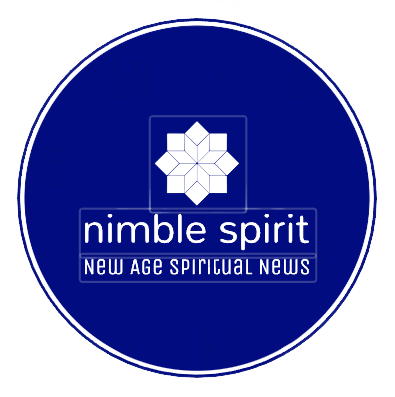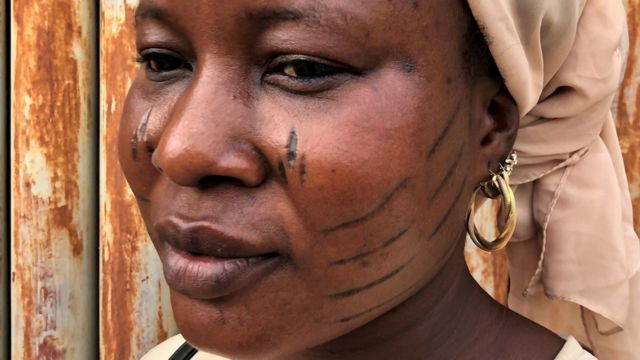- By Nduka Orjinmo
- BBC News, Abuja
Photo credit, BBC/ Nduka Orjinmo
Facial scarification was once popular throughout Nigeria.
Deep cuts, usually on both cheeks or the forehead, were engraved on children by families and communities, most often as a mark of identity.
These marks also contained stories of pain, reincarnations and beauty.
To read especially on BBC Africa:
This practice, however, has been dying out since a federal law banned all forms of child mutilation in 2003.
The current bearers of these facial markings are therefore the latest generation, whose features are as varied as the many ethnic groups of Nigeria.
Photo credit, BBC/ Nduka Orjinmo
The 15 scars on Inaolaji Akeem’s face (above) identify him as a member of the Owu Kingdom in Ogun State, southwestern Nigeria.
Mr. Akeem is of royal descent, which is why he has long stripes on his face.
“It’s like a football shirt,” he jokes, adding that they made it popular in the local market.
On a more serious note, Mr Akeem says he considers scars sacred and he doesn’t think people should mark their faces just to make them look better.
This need for identification by facial markings was also strong in northern Nigeria, especially among the Gobir of Sokoto State.
Photo credit, BBC/ Nduka Orjinmo
The ancestors of Ibrahim Makkuwana, pastors from Gubur in present-day Sokoto, had no facial marks. But, he says, as they traveled in search of farmland, “they fought many battles and conquered many places”.
They then decided to make distinctive markings on their cheeks, “similar to those of their animals, which would help them identify their relatives during battle”, explains Mr Makkuwana.
“That’s where our brands come from,” he told the BBC.
But there is also a distinction between the Gobirawas.
Those with six scars on one cheek and seven on the other have parents descended from royalty. Those who have six marks on both sides only have their mother from the royal family.
Photo credit, BBC/ Nduka Orjinmo
Children of butchers have nine scars on one side and eleven on the other, while those with five and six scars on either side are hunters.
As for the fishermen, they have distinct markings extending to the ears.
Among the Yorubas and Igbos of southern Nigeria, certain marks are linked to life and death.
In their communities, it was believed that some children were destined to die before puberty.
Called Abiku and Ogbanje respectively by the two ethnic groups, these children belonged, according to the Yoruba, to an assembly of demons living in large iroko and baobab trees.
It was common for women to lose several infants in succession, and it was thought that it was the same child, constantly reappearing to torment its mother.
These children were then marked to make them unrecognizable in the eyes of their spiritual companions so that they would remain alive.
Many of these child deaths are now known to be due to sickle cell disease, a common inherited disease among black people.
Photo credit, BBC/ Nduka Orjinmo
Yakub Lawal, in Ibadan, southwestern Oyo State, was marked as an Abiku.
“It’s not my first time on earth, I’ve been here before,” he says.
“I died three times, and on my fourth return I received these marks to keep me from returning to the spirit world,” he adds.
The stories of Abiku and Ogbanje are intertwined with those of people who bear marks in memory of a deceased family member or someone who is “reborn”.
Photo credit, BBC/ Nduka Orjinmo
The four horizontal marks and three vertical marks of Olawale Fatunbi were inscribed by his grandmother, who said he was a reincarnation of her late husband, who had these facial scars.
But Mr. Fatunbi would have preferred not to have them.
“I don’t really like them because I consider it child abuse, but it’s our culture,” he says.
Photo credit, BBC/ Nduka Orjinmo
With 16 marks on his face, it’s hard to miss Khafiat Adeleke. Even harder to miss is the huge sign at her store in Ibadan, where she took on the nickname Mejo Mejo (Eight Eight) – to represent the scars on her cheeks.
“People call me Mejo Mejo from here in Lagos.
“My grandmother gave them to me because I am an only child,” she says.
Photo credit, BBC/ Nduka Orjinmo
Some scars are made for beauty.
Foluke Akinyemi was scarred as a child, a deep throat cut on each cheek overseen by her father at the hands of a local circumciser, who also scarred her face.
“My father made the decision to mark me just for fun and because he thought it was beautiful.
“It sets me apart from others and I thank my parents for giving it to me,” she says.
Photo credit, BBC/ Nduka Orjinmo
Ms Akinyemi’s story is similar to that of Ramatu Ishyaku from Bauchi, north-eastern Nigeria, who has tiny whisker-like lacerations on either side of his mouth.
“It’s for beauty,” she says, adding that she also got her face tattooed around the same time.
When she was little, mustache marks and tattoos were popular in her village and she and her friends would go to the local hairdresser to get them done, she adds.
Photo credit, BBC/ Nduka Orjinmo
The marks on the face of Taiwo, who only gave her first name, are fading today but the memory of why she was carved is still there.
When her twin sister died a few weeks after she was born, Taiwo fell ill and a traditional healer recommended marking her face to prevent her from joining her twin.
She recovered a few days after the scarification, she says, but it didn’t make her like the marks on her face.
“I would rather not have marks on my face,” she says.
Photo credit, BBC/ Nduka Orjinmo
There are also those, like Murtala Mohammed in Abuja, who don’t know the story behind their brands.
“Almost everyone in my village in Niger State had one, so I never bothered to ask,” he says.
Photo credit, BBC/ Nduka Orjinmo
Facial marks were inscribed by local circumcisers and barbers like Umar Wanzam using sharp blades.
He describes this experience as painful and without anesthesia.
Many who, like Mr. Akeem, were scarred as children agree that it was right to stop facial scarification.
He did not pass the tradition on to his children, even before it was banned.
“I like the marks, but they belong to a different time and age,” he says.
You might also be interested in:
Mode of expression or vulgar mutilation, tattoos divide opinion.
All images are subject to copyright
We wish to thank the author of this article for this incredible web content
The latest generation of face marks in Nigeria – BBC News BBC Homepage
You can find our social media profiles , as well as other pages related to it.https://nimblespirit.com/related-pages/

